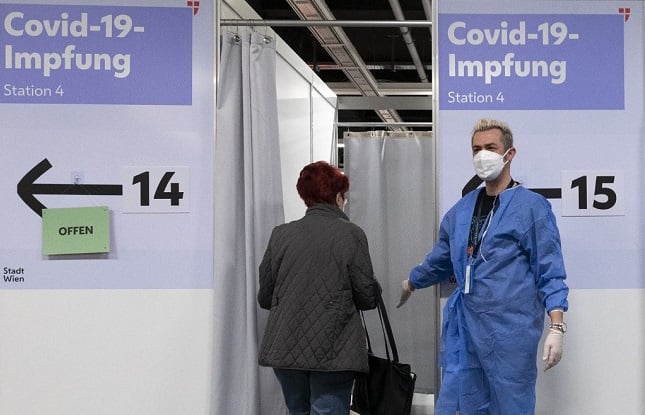After a day’s delay, Austria’s new government regulations on the coronavirus pandemic have been in force since Thursday, March 26th, but the capital Vienna has once again decided on stricter restrictions.
Here’s an overview of what the rules are regarding the pandemic in Vienna.
Stricter rules than the federal government
Vienna has kept a 2G rule (access for vaccinated or recovered people) for sports facilities and gastronomy, which has not been the case for the federal government, where no ‘G’ rules are obligatory.
Besides that, an FFP2 mask is still required in all indoor places, including in gastronomy, except at the seat, and in sports facilities, except while practising sports.
The rest of Austria has brought back the mask mandate but made it an option for night gastronomy and events with more than 100 people to have a 3G (vaccinate, recovered, or tested) rule instead.
READ MORE: Seven ways the Covid-19 pandemic has changed Austria
The quarantine rules are also very different in Vienna. In the rest of Austria, people who have tested positive will be able to end their quarantine on the fifth day without a test.
They will need to not have had any symptoms for 48 hours and should go into a transition phase of five days during which a mask must be worn at all times when in contact with other people, and they won’t be able to go to places such as gastronomy, sports facilities, and large events.
Vienna has not adopted these less strict measures. In the capital, those who tested positive can only end their quarantine on the fifth day if they don’t show any symptoms for at least 48 hours and test negative (or test positive with a CT value above 30).
READ MORE: How Covid absences are disrupting Austrian hospitals, schools and transport
Tests and workplaces
In Vienna, PCR test results must not be older than 48 hours, and antigen tests are valid for 24 hours, but only those made by authorised institutions, such as pharmacies and test roads.
There is no longer the need to prove vaccination status or show a workplace test result. However, there are separate rules for hospitals and nursing homes.
Trade, gastronomy, and hotels
In trade, an FFP2 mask requirement is still valid for all customers. For employees, the requirement only applies when in direct client contact. For body-related services, there is a mask mandate for customers and staff.
In Vienna, there is a 2G rule for gastronomy and a mask mandate for guests (when not seated) and staff. There is no longer a curfew, so night gastronomy is allowed to reopen with a 2G rule and a mask mandate for staff.
In the tourism sector, hotel guests no longer need to show any G proof. Still, there is a mask requirement in public areas and the 2G rule for the bars and restaurants within the hotel.
Events and leisure
There is no longer a limit of participants in events in Vienna. However, masks must still be worn when the event is indoors – regardless of any 3G rule of entry. In addition, for more than 50 attendees, the event must have a “prevention concept” presented to municipal authorities.
In theatres, cinemas, concert halls, museums, exhibitions, libraries and libraries, an FFP2 mask requirement applies indoors, but no G-rules.
The 2G rule continues to apply to indoor sports in Vienna, so for gym visits. People need to wear an FFP2 mask except for when they are exercising. There are no more restrictions on outdoor sports.
READ MORE: Covid-19: No change for mask rules in schools
Rules for children and minors
Children under the age of five are exempt from any G-rules.
When they are six to 12 years old, they must comply with a 3G rule wherever they exist for adults. In that case, PCR tests are valid for 48 hours and antigen for 24 hours. A valid “ninja passport”, with tests carried out in schools over the week, is also valid on weekends.
For children between 12 and 15 years old, there is a 2.5G rule (vaccinated, recovered, or PCR-tested). The ninja passport cannot be used as an entrance test for this age, and the last PCR is valid for 48 hours.
After the end of compulsory schooling, the same rules apply to adolescents as to adults.
Hospitals and nursing homes
Here the rules are also stricter in the capital than those in the rest of the country.
In hospitals, only one visitor per day per patient is allowed, and there is a 2G+ rule for visitors. For nursing homes, two visitors per day per resident are allowed, and they must also show 2G+ proof.
Additionally, an FFP2 mask must be worn for the entire duration of the visit.
Reminder: 2G+ means that the person must prove that they are fully vaccinated against Covid or have recently recovered from the disease. In addition to that, they must provide a negative test result.
READ MORE: UPDATED: Austria brings back mandatory FFP2 masks indoors as Covid cases soar
Useful vocabulary
Gültigkeit – validity
Handel und körpernahe Dienstleistungen – commerce and “body-related” services
Zusammenkünfte – meetings
Veranstaltungen – events
Nachweis – proof, certificate
Important links



 Please whitelist us to continue reading.
Please whitelist us to continue reading.
Member comments